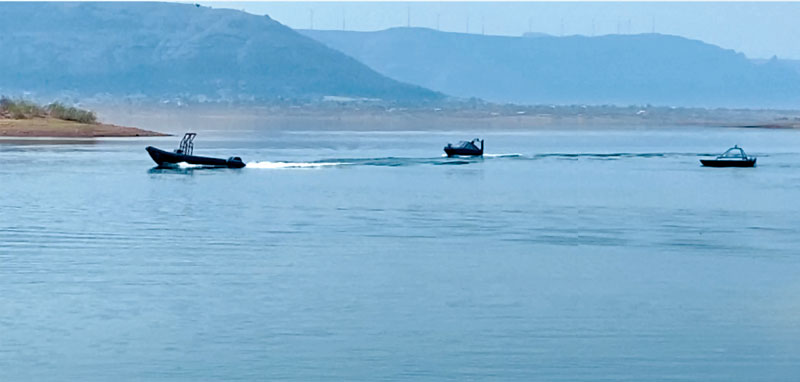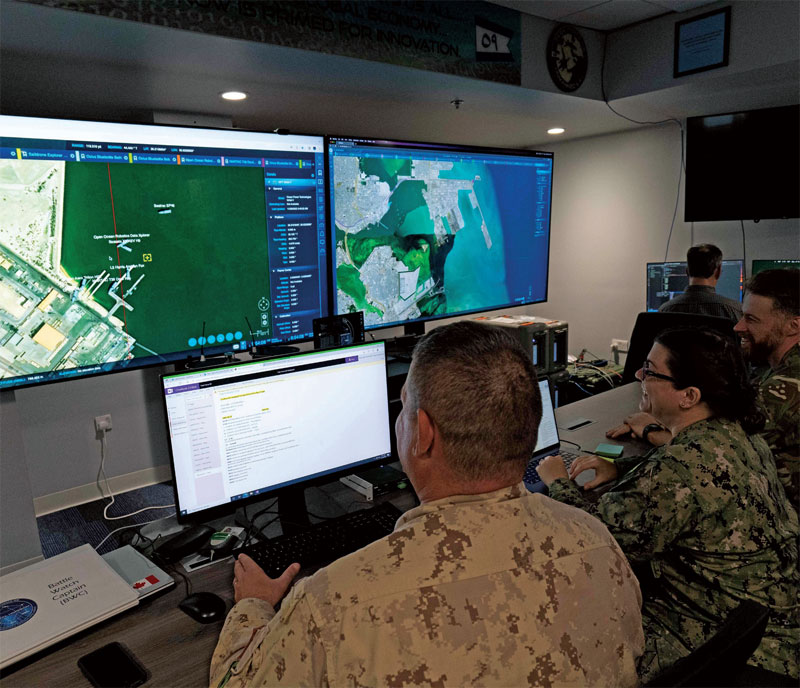New tactic allows deployment of many small boats to overwhelm naval defences
Smruti Deshpande
In January this year, the Indian Navy signed a contract for autonomous armed boat swarms with Sagar Defence Engineering. This was the 50th such contract under Supporting Pole-Vaulting in R&D (SPRINT) via Innovations for Defence Excellence, launched in July 2022. It aims at developing 75 indigenous technologies by the defence industry for the Navy. Under the (DISC 7) SPRINT initiative, the Indian Navy has placed an order for an undisclosed number of systems of the country’s first autonomous weaponised boats that have the capability of swarming to enhance maritime security operations by carrying out a variety of security and naval activities rigorously.

During the Bandhan ceremony at Aero India 2023 in February, Sagar Defence signed an MoU to develop autonomous weaponised boat swarms to collaborate on the Indian design developed and manufactured (IDDM) for India and the global market by October 2023.
This development is significant given the rise of unmanned systems across sectors the world over. For militaries to have unmanned systems, whether on the ground, in the air or in water, they must employ capabilities that will have zero to no human toll. In high-risk environments, unmanned systems also come in handy in delivering ordnance. Some of the most advanced countries worldwide have been inducting systems including unmanned aerial vehicles (UAV) and unmanned ground vehicles (UGV) to be deployed in battlefields. Due to sophisticated sensors and precision weapons atop these systems, militaries get real-time data and prevent the vulnerability of assets in their territory.
The emergence of unmanned systems has played a decisive role in several conflicts in different parts of the world. The US employed several unmanned aerial vehicles (UAVs) in Iraq and Afghanistan such as the MQ-1 Predator and MQ-9 Reaper. Unmanned Ground Vehicles (UGVs) such as TALON and PackBot were mainly used for bomb disposal and reconnaissance. Furthermore, systems such as Unmanned Underwater Vehicles (UUVs) such as the REMUS and Swordfish were also used by the US navy for mine detection and underwater reconnaissance. The US air force made strategic use of the C-17 Globemaster III which was modified with autonomous flight control systems to deliver supplies and cargo to remote areas. Put together, these systems were used for surveillance, reconnaissance and targeted strikes against enemy combatants, meaning that US forces benefited from improved real-time situational awareness, shielding US military personnel from risks while helping them set up better combat and support aid.
Similarly, when Azerbaijan used the Turkish kamikaze Bayraktar TB2 drones and loitering munitions, many of them Israeli-made, over the skies of the disputed Nagorno-Karabakh eventually winning the air war, it was clear that this technology was not limited to the US and Russia militaries. During this conflict, the unmanned aerial systems proved that countries having such prowess can take precise aims and shoot down troops, infantry as well as artillery positions, tanks and other important assets of the adversary with utmost ease and more importantly, with low financial investment into such assets. Foreign Policy quoted Col Scott Shaw in 2021 when he was the outgoing head of the Army’s Asymmetric warfare as saying, “What has become apparent after Azerbaijan routed Armenia last fall is that not only will the US military no longer enjoy uncontested air superiority against peer rivals like China—something Defence Department officials have long resigned themselves to—but that poorer nations can buy themselves a respectable air force mostly off the shelf.”

Today, automation has graduated well beyond air and land, as is evident from the ongoing Russia-Ukraine conflict. While both countries have been employing every military might available, unmanned systems have made a breakthrough in attacks and counterattacks. One of the most prominent examples is Ukraine’s use of uncrewed boats. In November 2022, Ukraine carried out a drone attack on the Black Sea Fleet in the Crimean port city of Sevastopol, damaging one warship. Russia called the attack ‘massive’ and said Ukraine used nine drones. It blamed Ukraine for blowing up gas pipelines. Further, Russia claimed that all unmanned aerial vehicles were shot down and no ‘civilian infrastructure’ was damaged.
Russia’s ministry of defence said, “At least one vessel sustained minor damage.” It added, “In the course of repelling a terrorist attack on the outer roadstead of Sevastopol, the use of naval weapons and naval aviation of the Black Sea Fleet destroyed four marine unmanned vehicles, three more devices were destroyed on the internal roadstead.” While Ukraine did not own up to the attack at first, Ukrainian authorities said they hoped to raise enough funds to buy 100 drone boats, which would be capable of striking targets as far away as 500 miles.
Through its UNITED24 fundraising platform as part of an effort to crowdsource funding for the boats, Ukraine stated, “Since February 24, the Russian army has launched more than 4,500 missiles at Ukraine. 20 per cent of them came from the sea. Ukraine had nothing to oppose these ships because the Ukrainian fleet lost 80 per cent of its vessels after the occupation of Crimea in 2014. But, on 29 October 2022, naval drones [that] hit Russian ships, were carried out exclusively by unmanned devices.”
It added that with the use of fsmall and fast unmanned ships, two Russian vessels were damaged, including the Admiral Makarov, flagship of the Russian Black Sea Fleet. This is the first case in history where the attack was carried out exclusively by unmanned vessels. “The result of this daring operation was incredible—Russia has lost its undeniable advantage on the water. The killers of Ukrainian civilians—warships armed with missiles—became targets themselves,” Ukraine stated.
Ukraine’s reason for the procurement of these drones is that they can participate in long-range maritime reconnaissance and coastal surveillance, escorting and supporting the traditional fleet, convoying merchant ships, zoning in artillery fire, defending its bases and countering amphibious operations.
A few months later in February 2023, Russia struck back. It came up with a kamikaze drone boat and attacked the Zakota bridge, south of Odessa, which connects to Moldova. This was Russia’s first known use of such an equipment.
Business Insider, in a report, stated that while some analysts on Twitter suggested it was a drone boat carrying explosives, others suggested it could be an Uncrewed Surface Vessel (USV).
According to the Daily Mail, Evgeny Poddubny, military correspondent for Russian state broadcaster VGTRK, said, “Almost a year after the start of the special military operation, we have started using marine unmanned drones.”
An uncrewed surface vessel and a drone boat are both types of unmanned watercraft, but they are different in usage. A USV can be operated autonomously or remotely controlled by a human operator from a remote location, without necessarily having a human onboard. USVs are typically designed for a variety of applications such as oceanographic research, maritime surveillance, environmental monitoring and even commercial shipping. They can vary in size from small, inflatable boats to large vessels capable of transoceanic voyages.
On the other hand, a drone boat is a type of USV that is specifically designed for military applications, such as naval operations, intelligence gathering and reconnaissance missions. Drone boats are typically smaller in size and highly manoeuvrable, equipped with advanced sensors and weapons systems, and often operate in swarms or groups. Drone boats are meant to be remotely controlled. USVs can be used for a range of civilian and military applications, but drone boats are restricted for military use.
Public Affairs Officer Capt. Jeff Klassen told the CBC that the Royal Canadian Navy was watching the development in USVs closely and was working with ‘other organisations and militaries’ to test small ‘remote surface vehicles.’ It already uses five-metre-long drone boats called Hammerheads, which are piloted by remote control, as targets in weapons exercises. One of the main arguments for Canada to embrace drone boats is that they could help patrol the country’s massive coastline. ‘The US already operates two fully autonomous ships called Sea Hunter and Seahawk, each of which is nearly 40 metres long,’ the CBC reported. A navy strategic account executive with Leidos and a retired US Navy Rear Admiral Nevin Carr told the CBC that these drone boats would handle some of the “dull, dirty and dangerous work the navy tackles including mapping the sea floor, going into toxic or radioactive environments or combat zones.”
As more navies opt for autonomous systems they look at factors such as cost-effectiveness, reduced risk to human life, enhanced capabilities, strategic advantage and flexibility by reprogramming and redirecting these systems. India has somewhat started looking in this direction.
Several countries have been testing the boat swarm technology. Boat swarms are a naval tactic where many small, unmanned or manned boats are deployed in coordinated fashion to overwhelm an adversary’s naval defences. The boats are typically equipped with various types of weapons and sensors and can be remotely or autonomously controlled.
Boat swarms have become increasingly relevant in modern naval warfare because of advances in technology that have made unmanned boats more capable and because of the challenges posed by traditional naval defences against multiple, fast-moving targets. They can be used for a variety of purposes, including protecting naval assets to conduct surveillance and reconnaissance or to attack enemy ships. The concept of boat swarms is not new and has been used in naval warfare throughout history.
The US Navy in 2014 demonstrated the capability of controlled swarms of unmanned boats with a high level of autonomy. The Office of Naval Research (ONR) tested armed and robotic USVs to not only protect its navy ships but also to offensively ‘swarm’ hostile vessels. The technology called CARACaS (Control Architecture for Robotic Agent Command and Sensing) can be put into a transportable kit and installed on almost any boat.
The US navy has been developing USVs for several years, working on a project called ‘Ghost Fleet Overlord,’ which is focused on developing and deploying unmanned boats in swarms. The project reportedly ended in early 2022 and four of its unmanned ships were transferred to the navy for surface warfare squadron, which is exploring ways to incorporate unmanned vessels into the fleet.
China released a video in 2018 of a 56-boat drone swarm near the Wanshan islands south of Hong Kong. Experts pointed out that the drone was L30 developed by Yunzhou-Tech.
In 2022, the WarZone reported that China had launched a drone ship that acts as a mothership for more drones. The official purpose of the design is ocean research, however, the portal stated that it will have value for the country’s military. Apart from the US and China, countries including Russia, Iran, Israel, France and the United Kingdom are exploring the use of unmanned boat swarms for various purposes.
Indian Navy and Boat Swarms
India has been taking efforts to develop autonomous swarm boats which would ensure maritime security and be on a par with the global development of technological advancements in the unmanned arena.
Ahead of DefExpo2022, the DRDO and Sagar Defence tested three unmanned remotely controlled weaponised boats in Pune. The boats that were tested had an endurance of around four hours. The boats can sail 10 nautical miles an hour and can be further increased to 25 nautical miles per hour. Some variants of these boats use electric propulsion system with lithium batteries.

Speaking to FORCE about the idea behind the swarm boats and how useful the system would prove for the Indian Navy, Sagar Defence Engineering Pvt Ltd Co-Founder & CEO Captain Nikunj Parashar said: “Autonomous weaponised boats operate on the surface of the water with dual use operation, that is, with or without a human onboard.”
Boat swarms have proved their mettle and are crucial for a variety of purposes in the twenty-first century, including oceanography, bathymetric survey, hydrographic survey, environmental monitoring, cargo transport, search and rescue and other military applications.
Captain Parashar added, “The autonomous vessel has an integrated system that can carry out a range of security and military tasks, such as littoral/ODA patrol, high speed interdiction, coastal surveillance, local naval defence, constabulary operations, C4ISR, and low intensity maritime operations (LIMO). Operations involving intelligence surveillance and reconnaissance can gather and transmit real-time data even in rough seas and high surfs, saving cost, time and most of all, human lives.”
These boats will be 8-15 metres in length and one swarm will include 12 boats in it. Each boat will be hybrid in nature and can be operated in manned as well as unmanned scenarios. They will have two types of swarming capabilities—centralised and decentralised. In the case of centralised capabilities, there will be a man in the loop, allowing them to be operated from a mothership or from ground earth stations. This means different boats can be made to perform different functions akin to a leader and a follower process. In the case of decentralised capabilities, boats will talk to each other and depending on the mission scenario, any one of them can become a leader and the rest will follow. It depends on what kind of applications the platform will be carrying out.
Captain Parashar said such boats can perform a variety of tasks such as reconnaissance, mine and submarine detection and forward-operating attack missions so that the crew remains at safe distances while anticipating threats and performing maritime combat operations. These autonomous systems have the capability to be unmanned in open seas while being controlled by a ground control station, which substantially increase ship protection as swarming is used to overwhelm opponents, defend sailors and coordinate maritime strikes across scattered oceanic regions.
Explaining what the recently signed memorandum of understanding (MoU) with Israel Aerospace Industries to develop autonomous weaponised boat swarms means, Captain Parashar said: “Under the MoU we aim to provide technology that will be useful in next-generation warfare for fleet defence, surveillance and reconnaissance. In order to make India a significant global manufacturing base by 2030, we look forward to developing Indian Design Developed and Made (IDDM) technologies for the worldwide market. The alliance has provided us with significant support to develop indigenous innovations for boosting the defence sector’s industrial and scientific capabilities.”
How will these boats be different from the traditional boats? Captain Parashar explained that this vessel was already capable of heavy-weather conditions and speeds above 40 nautical miles. This is more than close to 65/kmph and can go all the way up to 300 km per hour. These boats are capable of the launching weapon systems. He added that while the manned boats were designed for human operations, it is for the first time that a vessel was designed for both human as well as autonomous operations. “The technology superiority will be much higher compared to the existing platforms,” he said. The trials are expected to happen around August this year.
As a robotics startup, Sagar Defence develops autonomous technology that can be retrofitted on any platform, whether it be aerial, maritime or terrestrial. Apart from the development of autonomous boats they have also developed India’s first maritime spotter drone in collaboration with the Indian Navy, which can take off and land from moving platforms and has a wind resistance of 25 knots to provide surveillance, security and even medical assistance in high seas. It detects threats and oil spills while also providing a loud hailer warning to make operations easier. In addition, Sagar Defence also has to its credit the development of the first Personal Aerial Vehicle (PAV), originally designed for the Indian Navy to provide support to personnel during replenishment at sea operations but offers a variety of advantages such as casualty evacuation in the event of a traffic accident, usage as an air ambulance in far-off villages, use as an air taxi in big cities, emergency evacuations, disaster relief and medical emergencies, among others.
A source told FORCE that these autonomous boats would have a short-range missile system with a range of 40km. As of now, the missile is to be delivered by the navy, but the technology is not yet available in the country. In this scenario, the navy may ask Sagar Defence to partner with a foreign firm for manufacturing weapons. By this logic, the weapons manufacturing will then take the Make in India route. Post the initial prototype success Sagar Defence would have to take up manufacturing of the same in India.

